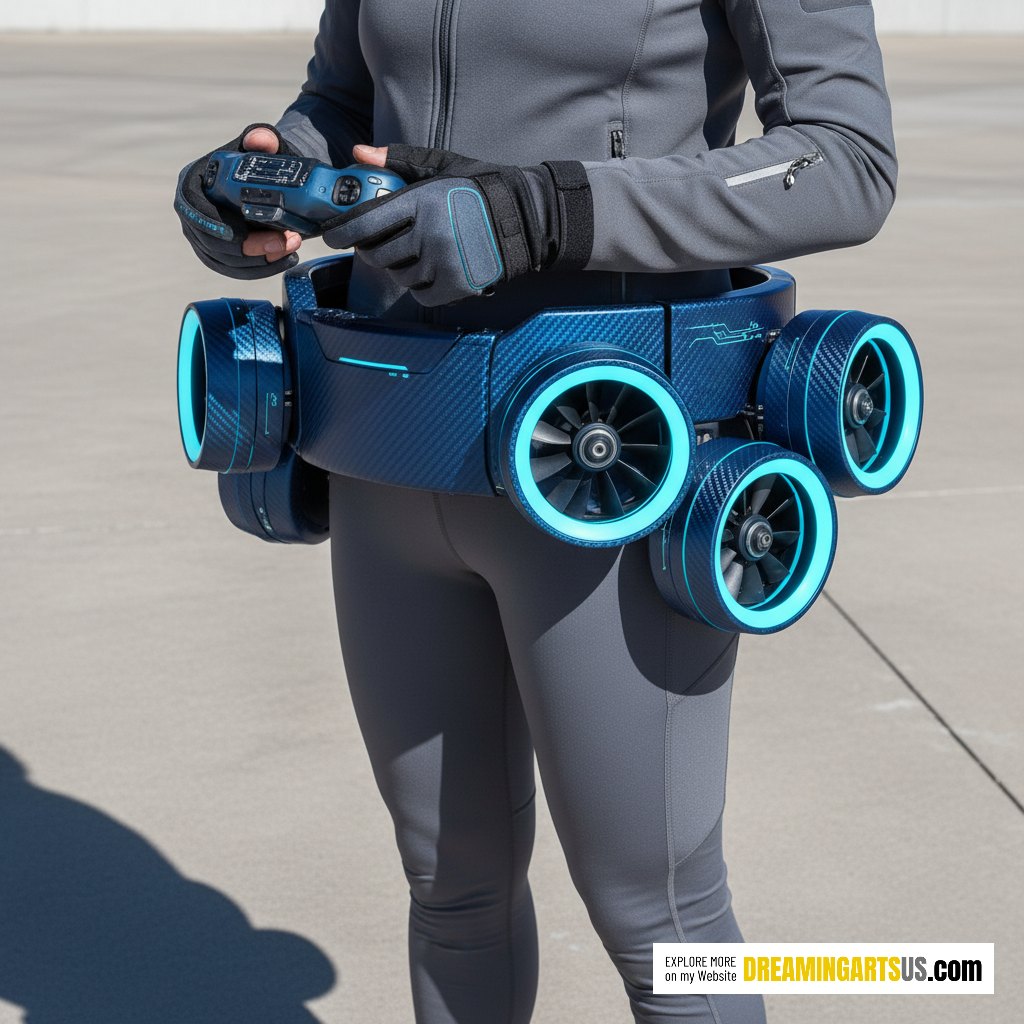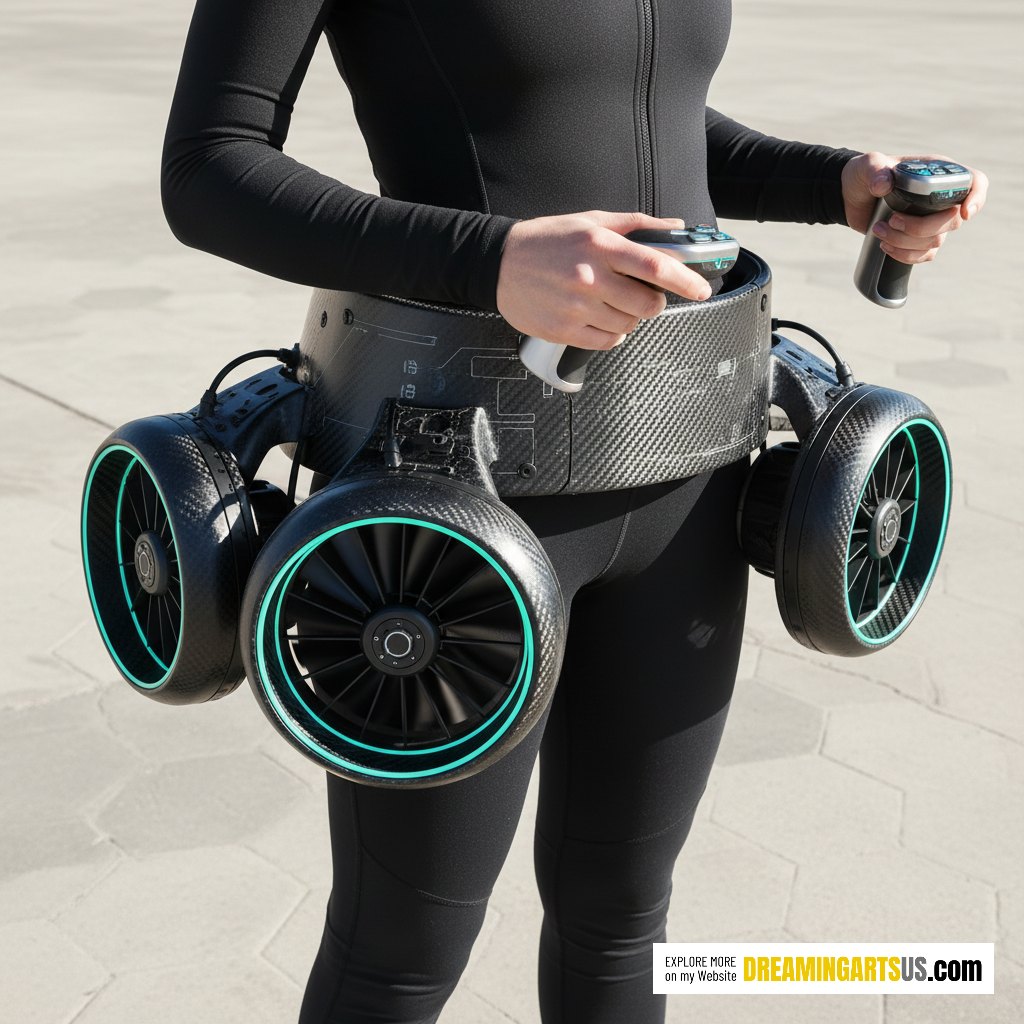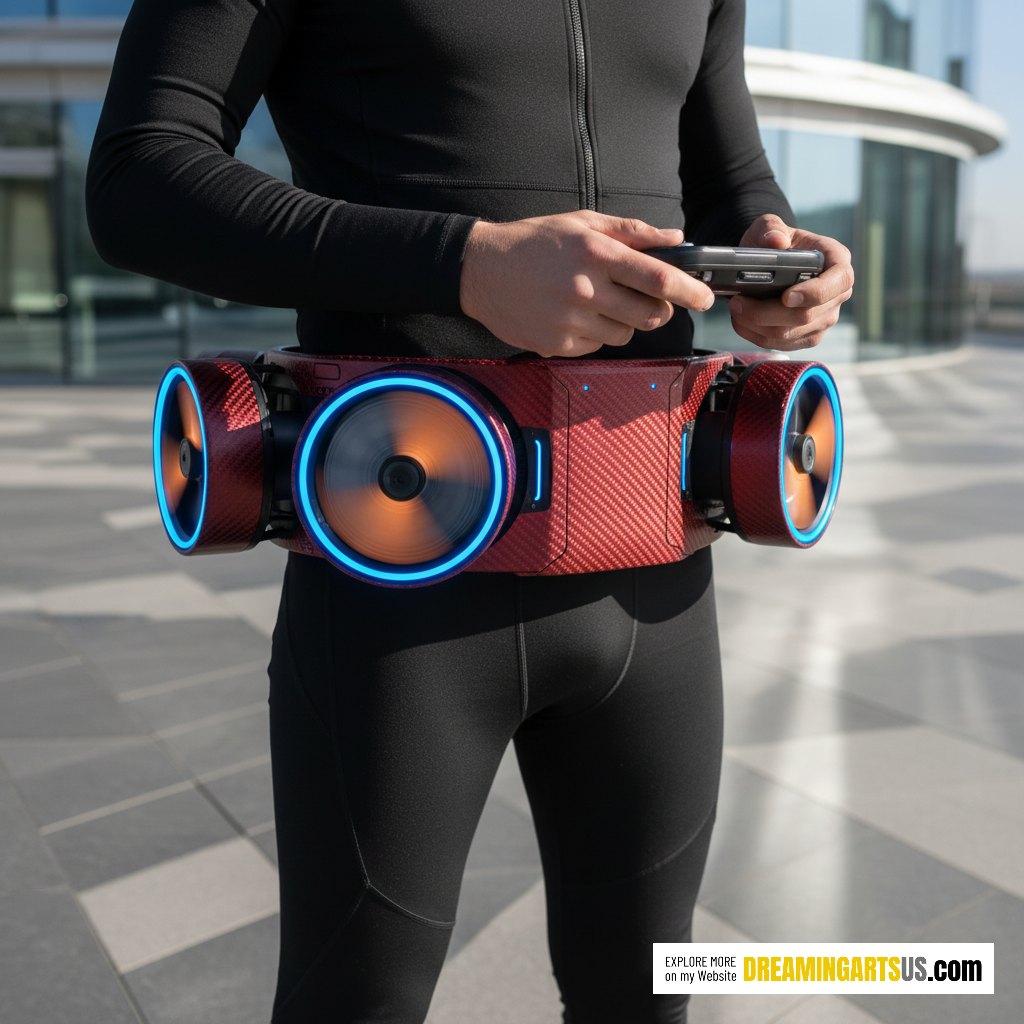Imagine strapping on a sleek, carbon-fiber belt that lets you defy gravity. No bulky jetpacks, no giant wings — just compact, high-thrust propellers mounted around your waist, ready to lift you into the air. This isn’t science fiction anymore. Waist-Mounted Drones represent a groundbreaking evolution in personal mobility, blending aerodynamics, robotics, and wearable technology into one astonishing innovation.
The era of walking, biking, or even flying traditional drones might soon feel outdated. With these futuristic flight belts, human mobility could take an entirely new direction — from commuting through crowded cities to emergency rescue operations and even recreational flight sports.

What Are Waist-Mounted Drones?
At first glance, Waist-Mounted Drones resemble high-tech belts equipped with multiple ducted fans or small turbines. Each propeller is strategically positioned around the waist to balance thrust, lift, and control. When activated, these drone units provide upward lift strong enough to support the user’s body weight, enabling controlled hovering and even short-distance flight.
They bridge the gap between traditional jetpacks and autonomous drones, offering stability and agility without the heavy fuel systems or bulk of old-school flight suits. Modern designs often integrate electric motors powered by lightweight lithium-ion or solid-state batteries, making them more eco-friendly and efficient than any previous personal flight system.
Engineering Meets Elegance: How the Technology Works
Behind the elegance of this technology lies a complex network of precision-engineered components. Here’s what powers these airborne marvels:
1. Electric Ducted Fans (EDF)
The core propulsion system uses high-efficiency ducted fans — compact yet powerful units capable of spinning up to 50,000 RPM. Each fan features variable thrust control, ensuring stability even during sudden directional changes or gusty winds.
2. Intelligent Flight Controller
The “brain” of Waist-Mounted Drones is an AI-driven controller that processes thousands of micro-adjustments per second. It reads input from gyroscopes, accelerometers, and barometric sensors to maintain perfect balance. Whether the wearer tilts forward or shifts weight, the AI compensates instantly.
3. Lightweight Materials
Most models are constructed using aerospace-grade carbon fiber, titanium, and advanced composites. These materials offer the perfect balance between strength and minimal weight — a necessity for human flight where every gram counts.
4. Battery & Power Management
Lithium-ion or emerging solid-state batteries power the fans. Though current flight time averages 10–20 minutes, battery swapping technology and portable charging stations are being tested to extend this limit significantly.
5. Human-Machine Interface
Users control the drone belt via handheld remotes, wrist controllers, or even gesture-recognition gloves. Some prototypes also feature AR (augmented reality) goggles that overlay flight data such as altitude, speed, and battery levels.
6. Safety Redundancy
Each propeller unit operates independently. In the event of motor failure, the remaining fans automatically rebalance thrust and initiate a soft emergency landing.
This integration of hardware and AI ensures that Waist-Mounted Drones aren’t just flight devices — they’re adaptive companions that respond to the human body in real time.

Safety and Design Innovation
Safety remains the cornerstone of personal flight technology. Engineers designing Waist-Mounted Drones have integrated multiple safety measures to protect users:
-
Automatic altitude limiters prevent users from flying beyond safe heights.
-
Emergency landing protocols activate if battery power drops below a certain threshold.
-
Collision-avoidance sensors detect nearby obstacles, adjusting thrust instantly.
-
Fail-safe harness systems ensure users stay securely attached, even in turbulence.
Design-wise, these drones are not just functional — they’re stylish. Their carbon-fiber bodywork, LED-accented fan rims, and aerodynamic contours make them look like something out of a sci-fi blockbuster. The glowing blue rings around the turbines add a sense of futuristic energy, turning each flight into a visually stunning experience.
Applications: Where Waist-Mounted Drones Will Soar
The potential for Waist-Mounted Drones extends far beyond personal entertainment. Let’s explore how they could transform multiple industries:
1. Urban Transportation
As cities grow denser, the need for compact and personal aerial mobility solutions becomes urgent. Waist-Mounted Drones could allow individuals to bypass traffic, flying short distances across rooftops or between nearby buildings — ideal for urban couriers, on-site engineers, or tech professionals.
2. Emergency Response
In rescue scenarios, every second matters. Firefighters or paramedics could use these drones to quickly access disaster zones or deliver life-saving supplies in areas unreachable by vehicles. Compact size and vertical lift make them perfect for tight or hazardous spaces.
3. Military & Tactical Operations
Defense technology has always embraced innovation. Waist-Mounted Drones offer silent flight, agile maneuverability, and reduced radar signatures — qualities that could redefine reconnaissance missions or tactical insertions.
4. Sports & Recreation
The thrill of personal flight is undeniable. Future extreme sports could include aerial races, obstacle courses, or drone-assisted parkour. These drones could also revolutionize cinematic filming by enabling athletes and creators to capture dynamic aerial perspectives effortlessly.
5. Industrial & Construction Use
Inspecting high-rise structures or tall wind turbines currently requires cranes or large drones. A worker equipped with Waist-Mounted Drones could hover safely at precise altitudes, performing maintenance without the need for scaffolding or lifts.

Advantages Over Traditional Jetpacks and Drones
While jetpacks have captured imaginations for decades, they’ve always faced challenges: weight, noise, and inefficiency. Waist-Mounted Drones overcome these hurdles through modern engineering:
| Feature | Jetpacks | Waist-Mounted Drones |
|---|---|---|
| Fuel Type | Combustion (kerosene/hydrogen peroxide) | Electric (battery-powered) |
| Noise Level | Very high | Moderate and smoother |
| Safety | High thermal risk | Cooler, AI-stabilized systems |
| Weight Distribution | Back-heavy | Centered around waist |
| Flight Time | Short (3–5 minutes) | Longer (10–20 minutes) |
| Environmental Impact | Polluting | Clean and renewable energy |
With advancements in lightweight materials and motor control systems, these wearable drones deliver a futuristic, efficient, and eco-conscious alternative to traditional flight technologies.
Links to purchase similar products: Click here
Challenges and Limitations
Despite their promise, Waist-Mounted Drones are still in their infancy. Some of the key hurdles include:
-
Battery Limitations:
Even with cutting-edge battery tech, sustained flight remains limited to under 30 minutes for most prototypes. -
Noise and Airflow Safety:
Although quieter than jet engines, the rotating fans still generate significant noise and wind pressure that can disrupt nearby pedestrians. -
Training Requirements:
Operating such a system safely demands learning balance, navigation, and understanding thrust dynamics — much like riding a motorbike or small aircraft. -
Regulatory Barriers:
Air mobility laws are still evolving, and authorities must adapt to categorize and manage these hybrid personal flight devices.
Overcoming these challenges will determine how fast Waist-Mounted Drones move from prototype to mainstream adoption.
The Evolution of Wearable Flight Devices
To understand how we reached this point, it helps to look back. Early flight suits and jetpacks from the mid-20th century were powered by dangerous fuels and lacked stability systems. Over time, drone technology evolved — miniaturized sensors, powerful brushless motors, and smart control algorithms created a perfect storm of innovation.
Waist-Mounted Drones are the logical next step — merging human mobility with autonomous drone intelligence. The trend fits perfectly within the rise of exoskeletons, smart wearables, and personal robotics that amplify human capabilities.
It’s not hard to imagine a near future where people commute using lightweight drone belts, similar to how electric scooters became ubiquitous a decade ago.
Real-Life Prototypes and Development Efforts
Several tech startups and aerospace innovators are already exploring Waist-Mounted Drones. Their designs vary in form and function:
-
Quad-thrust designs for balanced vertical lift.
-
Carbon fiber frames to reduce weight and increase durability.
-
LED navigation rings that improve night-time visibility.
-
Bluetooth connectivity allowing integration with flight-tracking apps.
These prototypes often undergo extensive field tests — focusing on thrust stability, user comfort, and emergency landing performance. Many of them are currently being refined for shorter hover sessions before scaling to full airborne travel.

Environmental and Social Impact
As global cities seek sustainable alternatives to ground vehicles, Waist-Mounted Drones offer a glimpse into a greener, more dynamic mobility era. Being fully electric, they eliminate fossil fuel emissions. Furthermore, their small footprint means less urban congestion and reduced infrastructure dependency.
From an accessibility standpoint, these drones could one day provide mobility solutions for people with disabilities — enabling new forms of independence and personal transportation.
Socially, they redefine how we perceive movement. Just as smartphones transformed communication, wearable flight could transform how we interact with our physical environments.
Future Vision: Everyday Flight Becomes Reality
In the next decade, Waist-Mounted Drones could evolve into fully integrated flight systems — combining AI-assisted navigation, voice controls, and extended battery endurance. Imagine commanding your device to “take me to work,” and effortlessly lifting above the morning rush.
Integration with smart cities might include designated flight corridors and charging hubs, while AI would manage traffic flow to prevent collisions. With augmented reality helmets providing navigation overlays, flying could become as intuitive as driving a car.
Ultimately, this technology represents humanity’s desire to merge with flight — not through massive machines, but through wearable, intelligent systems that feel like a natural extension of our body.
Waist-Mounted Drones are more than a technological marvel — they’re a symbol of human creativity, ambition, and the relentless pursuit of freedom. From science fiction dreams to engineering breakthroughs, these compact flight belts bring us closer to a world where flying isn’t reserved for pilots or superheroes — it’s accessible to everyone.
As innovation continues to shrink technology and expand possibilities, we may soon see the day when stepping outside doesn’t mean walking or driving, but gently rising into the air with effortless control. The future of personal air mobility has arrived — and it’s strapped right around your waist.


